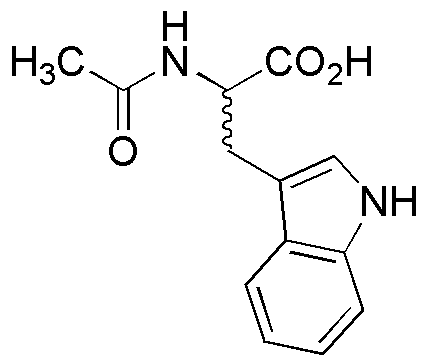N-Acetyl-DL-tryptophan is widely utilized in research focused on
- Pharmaceutical Development: This compound serves as a precursor in the synthesis of various pharmaceuticals, particularly those targeting neurological disorders, enhancing mood and cognitive function.
- Dietary Supplements: It is commonly found in dietary supplements aimed at improving sleep quality and reducing anxiety, making it popular among wellness brands.
- Biochemical Research: Researchers use it to study metabolic pathways and protein interactions, providing insights into amino acid metabolism and its effects on human health.
- Cosmetic Formulations: The compound is incorporated into skincare products for its potential antioxidant properties, helping to protect skin cells from oxidative stress.
- Food Industry: It can be used as a flavor enhancer or additive in food products, appealing to manufacturers looking to improve taste profiles while maintaining nutritional value.
General Information
Properties
Safety and Regulations
Applications
N-Acetyl-DL-tryptophan is widely utilized in research focused on
- Pharmaceutical Development: This compound serves as a precursor in the synthesis of various pharmaceuticals, particularly those targeting neurological disorders, enhancing mood and cognitive function.
- Dietary Supplements: It is commonly found in dietary supplements aimed at improving sleep quality and reducing anxiety, making it popular among wellness brands.
- Biochemical Research: Researchers use it to study metabolic pathways and protein interactions, providing insights into amino acid metabolism and its effects on human health.
- Cosmetic Formulations: The compound is incorporated into skincare products for its potential antioxidant properties, helping to protect skin cells from oxidative stress.
- Food Industry: It can be used as a flavor enhancer or additive in food products, appealing to manufacturers looking to improve taste profiles while maintaining nutritional value.
Documents
Safety Data Sheets (SDS)
The SDS provides comprehensive safety information on handling, storage, and disposal of the product.
Product Specification (PS)
The PS provides a comprehensive breakdown of the product’s properties, including chemical composition, physical state, purity, and storage requirements. It also details acceptable quality ranges and the product's intended applications.
Certificates of Analysis (COA)
Search for Certificates of Analysis (COA) by entering the products Lot Number. Lot and Batch Numbers can be found on a product’s label following the words ‘Lot’ or ‘Batch’.
Numéro de catalogue
Numéro de lot/série
Certificates Of Origin (COO)
This COO confirms the country where the product was manufactured, and also details the materials and components used in it and whether it is derived from natural, synthetic, or other specific sources. This certificate may be required for customs, trade, and regulatory compliance.
Numéro de catalogue
Numéro de lot/série
Safety Data Sheets (SDS)
The SDS provides comprehensive safety information on handling, storage, and disposal of the product.
DownloadProduct Specification (PS)
The PS provides a comprehensive breakdown of the product’s properties, including chemical composition, physical state, purity, and storage requirements. It also details acceptable quality ranges and the product's intended applications.
DownloadCertificates of Analysis (COA)
Search for Certificates of Analysis (COA) by entering the products Lot Number. Lot and Batch Numbers can be found on a product’s label following the words ‘Lot’ or ‘Batch’.
Numéro de catalogue
Numéro de lot/série
Certificates Of Origin (COO)
This COO confirms the country where the product was manufactured, and also details the materials and components used in it and whether it is derived from natural, synthetic, or other specific sources. This certificate may be required for customs, trade, and regulatory compliance.


